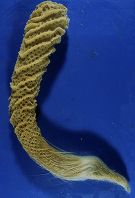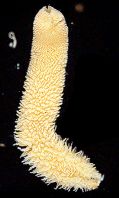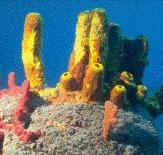
(hexactinellid sponge) |
PHYLUM PORIFERA
|

(calcareous sponge) |

(demosponge) |

(hexactinellid sponge) |
PHYLUM PORIFERA
|

(calcareous sponge) |

(demosponge) |
==2======== Hexactinellida (glass sponges; no regular canal system)
|
|========== Sclerospongia (coralline sponges; leucon type, silica & calcareous spicules)
<<===1==|
| ==4=== Calcarea (includes ascon, sycon & leucon grades)
==3==|
==5=== Demospongia (most living sponge species; leucon type)
TRAITS SUPPORTING EACH CLADE (** plesiomorphic- a primitive state, not unique to clade):
|
b) water canal system with pumping choanocytes** (monociliated cells with diplosome) c) extensive mesenchyme (gelatinous proteinaceous matrix containing skeletal material & amoeboid cells) d) silica spicules, initiated intracellulary e) pinacoderm (epithelium-like outer layer) lacking basal lamina & intercellular junctions f) dynamic tissue remodelling (reversible differentiation of most cell types) b) distinctive 6-pointed spicule (hexactine) c) most cells part of extensive syncytium |
b) transport of sperm to egg via choanocyte b) calcareous spicules b) spongocytes & spongin fibers c) distinctive 4-pointed spicule (tetraxon) |